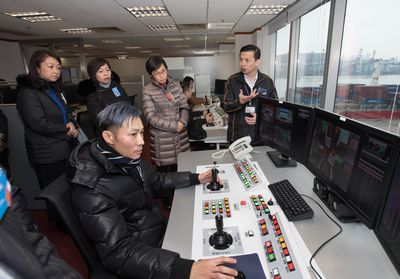 Angela Lee, deputy secretary for transport and housing; Alice Mak, legislative councillor; and Maisie Cheng, director of marine, visit the remote operations centre. |
Hongkong International Terminals (HIT) Container Terminal North has marked the launch of its remote-controlled rubber-tyred gantry cranes (RTGCs) and automated container stacking system. This landmark development made CT9 North the first container terminal in Hong Kong where all yard cranes are operated remotely and the stacking of containers is fully automated in the yard.
The remote-controlled operations project has opened a new chapter in the development of Hong Kong's container terminals, as it reinforces the competitiveness of the Hong Kong Port (HKP) while enhancing efficiency, occupational safety and the working environment of crane operators, according to the company.
The completion of the project is also unprecedented as it was the first time in the world for a container terminal to transit RTGCs to a remote-controlled and automated stacking system while maintaining full operations.
HIT claims to have pioneered a remote operation system of rail-mounted gantry cranes at its terminal in 2012. In late 2013, HIT started to configure 29 RTGCs, which had been manually operated by crane operators from crane cabins, into remote-controlled cranes. Simultaneously, it introduced an automated container stacking system. Both major developments took place at CT9 North.
Angela Lee, deputy secretary for transport and housing, said at the launching ceremony that the port has long been a cornerstone of Hong Kong's economic growth. As a leading hub port in the region, the success of HKP can be largely attributed to the efficient and professional management and services of the terminal operators, who have made continuous investments to capitalise on emerging technologies and to upgrade the port facilities. HIT's brand-new remote operation system not only raises the terminal's operational efficiency, but it also strengthens the competitiveness of HKP.